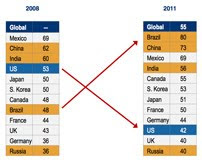After reading Jennifer Leggio's Forbes article "The Battle For Social Media Authenticity," one might wonder whether it is possible for brands (companies) to be authentic. It's a good question to ponder. They mostly can't.
This holds doubly true for the most dubious of brands — solo practitioners — people who spend all day developing a personal brand with surgical precision. From the clothes they wear to what they share, everything is orchestrated to create a persona that appeals to their tribe (a social media term meant to replace "audience" because it sounded so mass media). But the polish ought to be the tip off too.
How can you be authentic if everything is premeditated?
If authenticity is used to describe real people behind a content marketing program, then how can the program resolve its intent to drive sales and or engage people? That is, after all, the priority of most marketers online. In fact, according to the B2B Marketing Trends 2011 Survey, about 82 percent of marketers want to increase engagement* and 55 percent want to drive sales.
The irony is that if the primary objective is sales, searches, and shares, then the program is already one off authenticity. The objective alone tells the story. The intent isn't about the customer or prospect, it's about the company and the content strategist.
How To Flip The Content Funnel For More Sales And Engagement.
There has been considerable pressure over the years for social media to prove its merit. In most cases, marketers and public relations practitioners have leaned toward visibility measurements to prove their mettle: number of followers, website hits, search rankings, etc. They also mistake engagement for shareability (or the number of times someone else shares content), which also lends to those scores.
All of those metrics can be useful. But focusing on these metrics does not bode well for anyone concerned with authenticity and reputation. Consider point 13 on 15 Ways To Avoid Bad Online Reviews for example. It suggests creating a nest of brand evangelists that "you can count on when a sticky situation arises."
Can you imagine how this might play out in a physical location like a restaurant? It would feel much more awkward than it does online: One customer complains that there is a fly in their soup so 15 other patrons pounce on them to say their soup is fine. Maybe some will even accuse the complainer that the flies came in with her or him.
There is a better way and none of it needs to be contrived. You don't have to develop a social media program that elevates shares and sales as primary objectives because shares and sales work better as outcomes. The better objective ought to be severing prospects and/or customers.
1. Rather than using tactics to drive traffic, develop content that benefits an audience.
Companies that develop content that benefits or is interesting to an audience generally perform better than those that use social media to sell products and services. They outperform by earning a smaller audience's trust over the long term, which indirectly increases real engagement and sales.
It's not much different than the products or services themselves. Companies that develop better, innovative products or services earn sales. Companies that cater to specific online audiences — beyond news about the company — attract a larger audience.
2. Rather than ask social media spokespeople to be actors, ask them to be themselves.
There is nothing wrong with having a company account that shares content, specials, and company news. But there is more to managing a social network account than broadcasting the latest marketing message with a few jokes interspersed between the daily deals.
Authenticity is a trait exhibited by individuals, not companies. And in order to be authentic, employees need to have the freedom to be themselves more than a sales agent. After all, social networks are more akin to walking a convention room floor than a television channel. If your product or service doesn't meet the prospect's needs, let your employees tell them who might be the better fit.
3. Rather than play at reciprocity, consider your audience every step of the way.
Toss out all the rules and tips and tricks related to sharing. Sure, there are some surface benefits to sharing information at a rate of about 10 to 1 (ten links from others for every one link of yours) and people who tend to share (and follow) tend to share (and follow) back.
However, those surface tactics designed to make someone or something more popular don't further a well-defined strategy designed to benefit prospects and customers. Every shared link ought to benefit those who might be receiving the link rather than benefiting the account sharing the link.
How those three tips will improve your and your company's online reputation.
All three of these tips can be summed up quite easily. Make it about them instead of you or your company's social media tactics.
While doing so won't make your company authentic, it will go a long way in helping it establish a better reputation. It will also help you too, assuming people know the names behind the brand. Authenticity is demonstrated, not stated. And over the long term, it will always win out over something that is shallow and contrived like Ragu did. Make it about them, not you.
This holds doubly true for the most dubious of brands — solo practitioners — people who spend all day developing a personal brand with surgical precision. From the clothes they wear to what they share, everything is orchestrated to create a persona that appeals to their tribe (a social media term meant to replace "audience" because it sounded so mass media). But the polish ought to be the tip off too.
How can you be authentic if everything is premeditated?
If authenticity is used to describe real people behind a content marketing program, then how can the program resolve its intent to drive sales and or engage people? That is, after all, the priority of most marketers online. In fact, according to the B2B Marketing Trends 2011 Survey, about 82 percent of marketers want to increase engagement* and 55 percent want to drive sales.
The irony is that if the primary objective is sales, searches, and shares, then the program is already one off authenticity. The objective alone tells the story. The intent isn't about the customer or prospect, it's about the company and the content strategist.
How To Flip The Content Funnel For More Sales And Engagement.
There has been considerable pressure over the years for social media to prove its merit. In most cases, marketers and public relations practitioners have leaned toward visibility measurements to prove their mettle: number of followers, website hits, search rankings, etc. They also mistake engagement for shareability (or the number of times someone else shares content), which also lends to those scores.
All of those metrics can be useful. But focusing on these metrics does not bode well for anyone concerned with authenticity and reputation. Consider point 13 on 15 Ways To Avoid Bad Online Reviews for example. It suggests creating a nest of brand evangelists that "you can count on when a sticky situation arises."
Can you imagine how this might play out in a physical location like a restaurant? It would feel much more awkward than it does online: One customer complains that there is a fly in their soup so 15 other patrons pounce on them to say their soup is fine. Maybe some will even accuse the complainer that the flies came in with her or him.
There is a better way and none of it needs to be contrived. You don't have to develop a social media program that elevates shares and sales as primary objectives because shares and sales work better as outcomes. The better objective ought to be severing prospects and/or customers.
1. Rather than using tactics to drive traffic, develop content that benefits an audience.
Companies that develop content that benefits or is interesting to an audience generally perform better than those that use social media to sell products and services. They outperform by earning a smaller audience's trust over the long term, which indirectly increases real engagement and sales.
It's not much different than the products or services themselves. Companies that develop better, innovative products or services earn sales. Companies that cater to specific online audiences — beyond news about the company — attract a larger audience.
2. Rather than ask social media spokespeople to be actors, ask them to be themselves.
There is nothing wrong with having a company account that shares content, specials, and company news. But there is more to managing a social network account than broadcasting the latest marketing message with a few jokes interspersed between the daily deals.
Authenticity is a trait exhibited by individuals, not companies. And in order to be authentic, employees need to have the freedom to be themselves more than a sales agent. After all, social networks are more akin to walking a convention room floor than a television channel. If your product or service doesn't meet the prospect's needs, let your employees tell them who might be the better fit.
3. Rather than play at reciprocity, consider your audience every step of the way.
Toss out all the rules and tips and tricks related to sharing. Sure, there are some surface benefits to sharing information at a rate of about 10 to 1 (ten links from others for every one link of yours) and people who tend to share (and follow) tend to share (and follow) back.
However, those surface tactics designed to make someone or something more popular don't further a well-defined strategy designed to benefit prospects and customers. Every shared link ought to benefit those who might be receiving the link rather than benefiting the account sharing the link.
How those three tips will improve your and your company's online reputation.
All three of these tips can be summed up quite easily. Make it about them instead of you or your company's social media tactics.
While doing so won't make your company authentic, it will go a long way in helping it establish a better reputation. It will also help you too, assuming people know the names behind the brand. Authenticity is demonstrated, not stated. And over the long term, it will always win out over something that is shallow and contrived like Ragu did. Make it about them, not you.





































